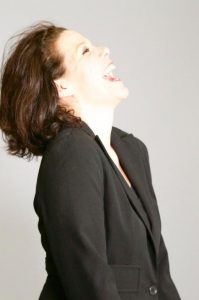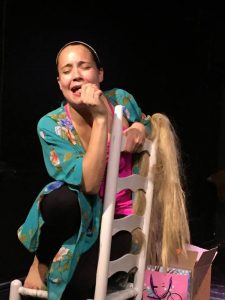

Bubbleheads, a one-act play at Theater for the New City's Dream Up Festival, offers audiences a dreamlike experience of divorce and remarriage through the eyes of a child. We spoke with director Heather Chamberlain about the challenges of bringing this world premiere to the stage, why we should purge realism from theater, and what classic play she'd most like to reinvent.
Pitch Bubbleheads to our readers in 3 sentences:
Bubbleheads is:
1. A “festive dark comedy” (as an audience member described it) about a little girl who wants to be seen -- both literally and metaphorically -- by her crazy, selfish, neurotic and highly dysfunctional family.
2. An experiment in blending physical clowning, absurdist theatre, disturbing comedy, using theatre lighting as its own comical device and an experiment in keeping the audience guessing whether or not this is actually a show, i.e. when are we “in” performance and when is this not a performance.
3. A weirdly satisfying risk to take in the theatre.
Bubbleheads is a cross between:
A child’s experience of incest, abandonment, rape and terror and hilarious comedy, intense audience interaction, theatrical barriers broken down, raw spectacle oddities in costume, props, lighting and physicality.
What was most challenging about bringing the show to the stage?
Shaping a world around the lines. Finding the actual spirit of the play. The playwright, Darcy Heller Sternberg, intentionally never labeled the script as a particular genre. There are no locations in the script and no insight into a character’s mood or feelings. We spent weeks taking the play down all possible roads of drama, tragedy, surrealist beauty but we always hit a wall when trying to figure out why we loved reading the play so much.
We couldn’t figure out why the play meant so much to us. The lines are extremely disjointed but poetic so to put the words into a context demanded we work at our utmost level of creativity.
I say “we” because as a director I insist on all voices being heard in the room, all ideas, and all interpretations. In all ways, I demand I have the actor’s brilliance fully at my disposal, which means we create together, not me alone. Probably 10% of what you see in the show is my idea and the other 90% the cast and crew’s ideas. It is the result of many minds stimulating each other.
Do you find having a small budget freeing or confining?
Ultimately freeing because when I have to be resourceful and create something out of nothing, the final product -- creation, rather -- has a much more complex, interesting, raw and vibrant personality than a product that money can buy.
Don’t get me wrong, having a Cirque du Soleil (one of my main creative influences and training is Cirque du Soleil, having spent the last seven years in Vegas) size budget means there is no limit to my imagination -- which will be nice someday.

Considering that theater is often able to touch on important social issues in ways that Hollywood and TV haven’t, what kinds of stories might you like to tell in the future?
Regarding what social issues, I feel like there is still a need for civil rights to be examined, race relations -- especially in America.
Regarding the type of stories I want to tell, particularly in New York City, there is a lack of the clown in theatre. Not the white-face Bozo but the Russian style of clown-work theatre. In Las Vegas I would go to tiny, crowded, dusty theatres just off the LV Strip at 1am to see the Cirque du Soleil clowns getting their art on, so to speak. Non-verbal, physical, intense, sometimes funny and sometimes melancholy, intensely focused performances. Without saying a word, an entire epic saga would be lived through onstage in the most memorable way. That’s what I want to create.
What would you change about the current state of theater?
All realism should be purged from the theatre. That doesn’t mean all realist scripts but all realism in the staging of the script must be abandoned. The theatre should be used to stimulate the imagination of the audience. When you walk into a theatre and the set is as detailed, literal and real-to-life as possible, you know your imagination probably won’t be very stimulated. When you walk into a theatre and see an ordinary chair onstage and nothing else, the sky is the limit on what you will see in your mind’s eye during the performance.
Save the real and the literal for television and film. Keep it out of the theatre.
What classic play/musical would you like to direct and how would you reinvent it?
Honestly, I want to rework a show I did two years ago. I feel like I still did not get it right. My directorial and creative debut in New York City was the version of Euripides’ Medea that I had dreamed of for so long. I put a gorgeous and highly skilled/trained male actor, Danny O’Conner, in the lead role, in drag. I have always, since the first time I read Medea, imagined “Nurse” to be a harpy -- half bird/half woman -- so I did that. “Chorus” was the land around Medea -- the trees, stones, wind around her. Something about the piece of theatre was not good -- well a lot of it wasn’t good to be fair -- and I must figure out where I went wrong with it. Maybe Medea should be a comedy. Yep. That’s what I will do with it someday -- make it funny.
What director’s career would you most like to emulate?
Swedish theatre director and choreographer Mats Ek. He has created a level of dance theatre that is unlike anything I’ve ever seen. I want to spend an hour in his mind, I think I might see the face of an actual theatre god.
Performances of Bubbleheads continue through September 12.